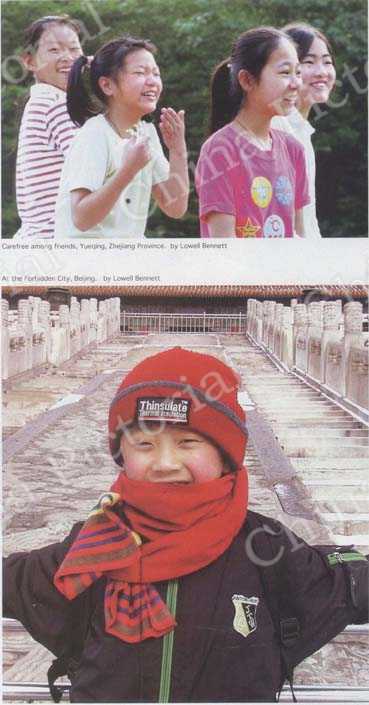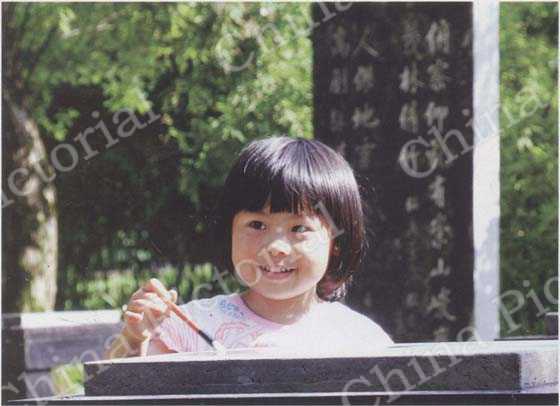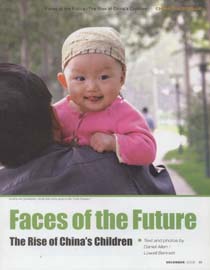
Stroling with Grandfather, things look pretty good to this "Little Empress."
Just 20 years ago, 80 percent of the Chinese population survived on less than a dollar a day. The most these families wished for was to keep enough food on the table.
No longer. The great pace of societal advancement in recent decades has allowed vast and increasing numbers of the nation's citizens to reach for and seize new opportunities. Greater freedom and increased affluence have brought significant lifestyle changes. For the young people of China, fast change and progress has indeed presented some challenges, but these adjustments are far outweighed by advantages and benefits that would have boggled the minds of elder generations -and does.
More than half of China's 1.3 billion citizens are less than 24 years of age. In this era of dramatic and accelerating societal advancement, it is the likes, dislikes, hopes, fears and dreams of these young people that will ultimately mold the China of tomorrow. And like never before in history, today the children of China reap the benefits of social change.
In general terms, in that most fundamental measure of a nation's progress, nutritional status has improved considerably over the last decade, with rates of malnutrition decreasing sharply. Last May the United Nations Children's Fund (UNICEF) declared that China had already achieved the target of a 50 percent reduction in its number of underweight children.
But rising prosperity does present an adverse byproduct downside. A major concern among health experts today is the rising obesity level among Chinese children. A recent survey found that 10 percent of children are now clinically overweight, with an expected 8 percent rise per year. Like many Western countries, the blame goes to high-fat, fast-food diets, too much TV, obsessive computer gaming, and not enough exercise.

Fueled largely by an increasingly energetic media, the growing sums Chinese parents lavish on a single child has led some to lament a spoiled generation. Thus the term "little emperor," meaning a self-centered Chinese child pampered at every turn by doting parents. Some among earlier generations believe a love of money and material possessions may be eclipsing more important societal priorities for the nation's youngest.
The increasingly pronounced demographic skewing of the Chinese population is a further concern. By 2020, the number of people over age 60 will number more than 240 million, or 12 percent of the population. Caring for the elderly is a mounting burden which both society and government must share in a way that doesn't limit progress or strangle aspirations.
Ensuring Education
Thanks to efforts by both the Chinese government and society at large, education of the young has realized significant progress over the last 20 years. Since the 1980s the government has heavily subsidized normal and vocational education, including education for minorities. In recent years China has established a comprehensive educational fund-raising system, with financial support from national and local government supplemented by funds collected through other channels.
While standards of schooling in China's affluent, eastern and southern urban areas are usually high, kids from poorer, agricultural and migrant worker backgrounds have traditionally been less well educated. However, times are changing. At the end of 2005 the government announced it would be investing more than US$ 15 billion to pay for compulsory education in rural areas, thereby ensuring a free nine-year education for every child. Before the start of the 2006 spring semester, the Chinese government invested more than US$450 million to cover the school fees of kids living in 12 western provinces, including Sichuan and Yunnan.
In the past, children who accompanied their migrant parents to the city were often charged school fees much higher than those charged by rural schools. But today the amended Compulsory Education Law, which went into effect in September, includes a new provision ensuring the right to a free education for migrant workers' children, irrespective of where they are living. Now, if migrant families are living and working in locations other than where they are registered, local governments must pay their educational expenses. The measure affects no small number of kids. According to the Ministry of Education, by the end of 2004 more than 6.4 million rural children of compulsory education age were living in cities with their parents.

A happy calligrapher, Lanting Garden, Zhejiang Province. by Lowell Bennett


Heralding Health
China's young are not only becoming better educated, they are also healthier. In terms of macro-level trends, China has the health profile of a middle-income country, with the general health of the population steadily improving. Quality healthcare is gradually becoming more widely available, and thanks to a well-developed welfare system, more than 95 percent of China's children are now vaccinated against a full range of infectious diseases.
Since the implementation of China's immunization program in the 1980s, carried out with the approval of the World Health Organization (WHO), the incidence of infectious diseases in children has sharply declined, with polio now totally eliminated. Commensurate with this advance, the child mortality rate in China has also dropped dramatically. The mortality rate for infants fell from 50.2 per thousand in the early 1990s to 32.2 per thousand in 2000, while that for children under five fell from 61 per thousand to 39.7 per thousand over the same period.
Future Fulfilled
Thanks to increased investment and more enlightened policy making, the number of teenagers graduating high school and going on to higher education continues to increase. And at all levels more and more kids are getting the opportunity to study, even in the poorest of rural areas. To underpin the fast-paced economic growth that China is currently enjoying, the government and the nation's citizens are well aware that a healthy, educated and skilled workforce is an invaluable resource.
With sensible planning, investment and guidance, China's kids will mature to move the nation forward. Before they assume their role as adults, however, many are enjoying a childhood quality of life beyond the wildest dreams of prior generations.


 Copy Reference
Copy Reference 